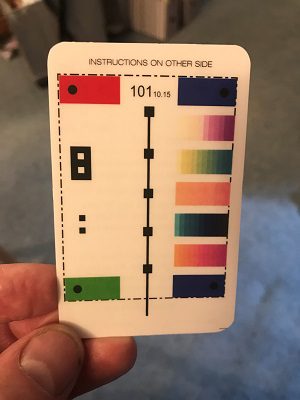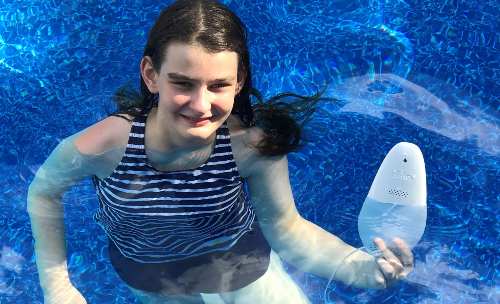With the coronavirus COVID-19 outbreak, this year’s “summer vacation” for many Americans is a staycation. For integrators, it has led to a boom in installations of outdoor audio and video system for clients to be entertained while enjoying their backyard swimming pool. But what about the pool itself? The $349 pHin pool and hot tub monitoring system is a perfect add-on sale for dealers. And for me, the “shocking” results from the pHin pushed me to switch my pool supplier.
Like many homeowners in the Northeast, maintaining my swimming pool is a labor of love… or hate… depending on how you look at it. Every year in May we “open” the pool and wonder what sort of surprises are in store for us. Opening the pool involves removing the safety cover, dragging the pool pump out of the basement and re-installing it, removing the various plugs and shields from the filter and hoses, thoroughly brushing and cleaning the pool interior surfaces, and, of course, adding the proper chemicals to the water.
Two years ago when we removed the cover it was a deep algae green-colored water. Yuck. This year, the 10,000-gallon pool water was crystal clear blue when the cover came off. Apparently, the extent of the winter has a lot to do with how the water fares from October through April. We’ve only had the pool for three years, and every year it has been different. One year there was literally a 9-inch layer of ice on top of the pool (I measured it.) This past winter, only a small layer of ice formed on top of the pool underneath the cover, and that was only for a short time period.
After the water is treated, the next step is the take a sample down the local pool supply store in town, where they test the chemistry of the water. Normally, we get a “you’re good to go” response from them and we are set for the season. During the summer, we will check the water chemistry a few times, adding chlorine tablets to the filtering system as needed.
And for our family, keeping the water clean is a big deal, especially this year. With a swimming pool, my 16-year-old daughter Avery has suddenly become much more popular with her friends this year, who are all forgoing summer travel trips. After we abided by the strict quarantine measures up here in Massachusetts, we have allowed her to have a few friends at a time over for swim parties… just in time for the summer heat. But the real necessity for the pool is our 12-year-old Fiona. Fiona is a fish. She is always in the pool, and once she gets in, she doesn’t get out.
So with that as a backdrop, we were excited to test the new pHin water chemistry monitor this season. Pool supply companies advise you to check your pool’s water chemistry once per week, but pHin has developed a smarter approach; it measures the water’s pH, sanitizer and temperature over 1,000 times per week.
Right out of the gate, we had a big surprise. pHin advises users not to deploy the device in the pool until after you have stabilized the water. So, a few days after we shocked the water to kill all the nasty bacteria that had been growing in the water all winter, we took the water sample down to the local pool store.
“You’re all set. The water is perfect,” was the advice I was given.
The next day, the pHin was thrown in the pool. The device itself shaped like a teardrop and is about 10.5-inches tall and 4.75-inches deep. It bobs in the water just like an old school pool thermometer does. pHin’s built-in intelligence collects the information on the water chemistry based on usage, weather, water temperature, sunlight exposure and other factors. It then analyzes the data and creates recommendations.
pHin Provides Mixed Results
I must admit that I thought the actual pHin device itself would do all those measurements digitally and simply send a report to my smart phone. Sure, it gives you the constant temperature reading, pH level and calcium hardness, but to get the details, you still have to physically dip a test strip into the water, then align it to a provided reference gauge. Then, must snap a photo of it using the pHin mobile app. Easy right? Not necessarily. The app advises you to make sure you snap the photo in direct sunlight. In my case, it seems to require me to snap the image four to five times before the app will accept the image… even when I am in direct sunlight.

Anyway, after our water was deemed “OK” by the pool company… the pHin had a different take, which was basically, “Get out of the water now!” The device showed that the Total Alkalinity in the water high, the pH (acidity/basicity) level was low, and the calcium hardness was too soft. Other measurements for Cyanuric acid levels and free chlorine were inline. What the heck?
So, we took our water sample to another local pool company as a third-party opinion. The third-party results partially confirmed and partially contradicted the pHin. In general, pool supply store measurements are often designed for speed; knowing that, pHin recognizes on its website that its measurements might differ from the local pool store’s recommendations, “but we find when customers follow our recommendations their pools are more likely to stay balanced,” it says.
The mobile app sends regular weekly alerts indicating the water quality. In our case, it has indicated that we need to apply chemicals to “shock” the pool weekly. Several times we have simply pushed the button indicating that we “shocked” the water, the pHin takes 19 hours to analyze the water. For those of us who often curse at the amount of time required to care for a swimming pool, the pHin might re-enforce those negative vibes because it is constantly reminding you to take care of it. pHin charges end users $99 per year to use the device. For integrators, they would want to bundle the device into a regular annual maintenance fee. If they want to charge more than the $99 annual fee in order to earn RMR, the dealer would have to put the pHin in his or her name, not in the client’s name.
















